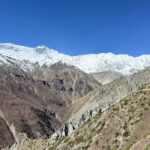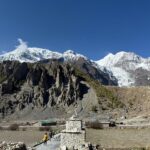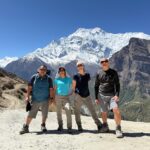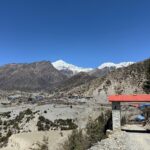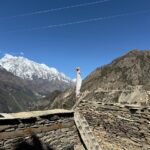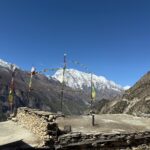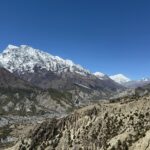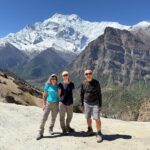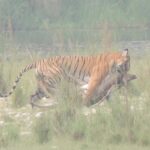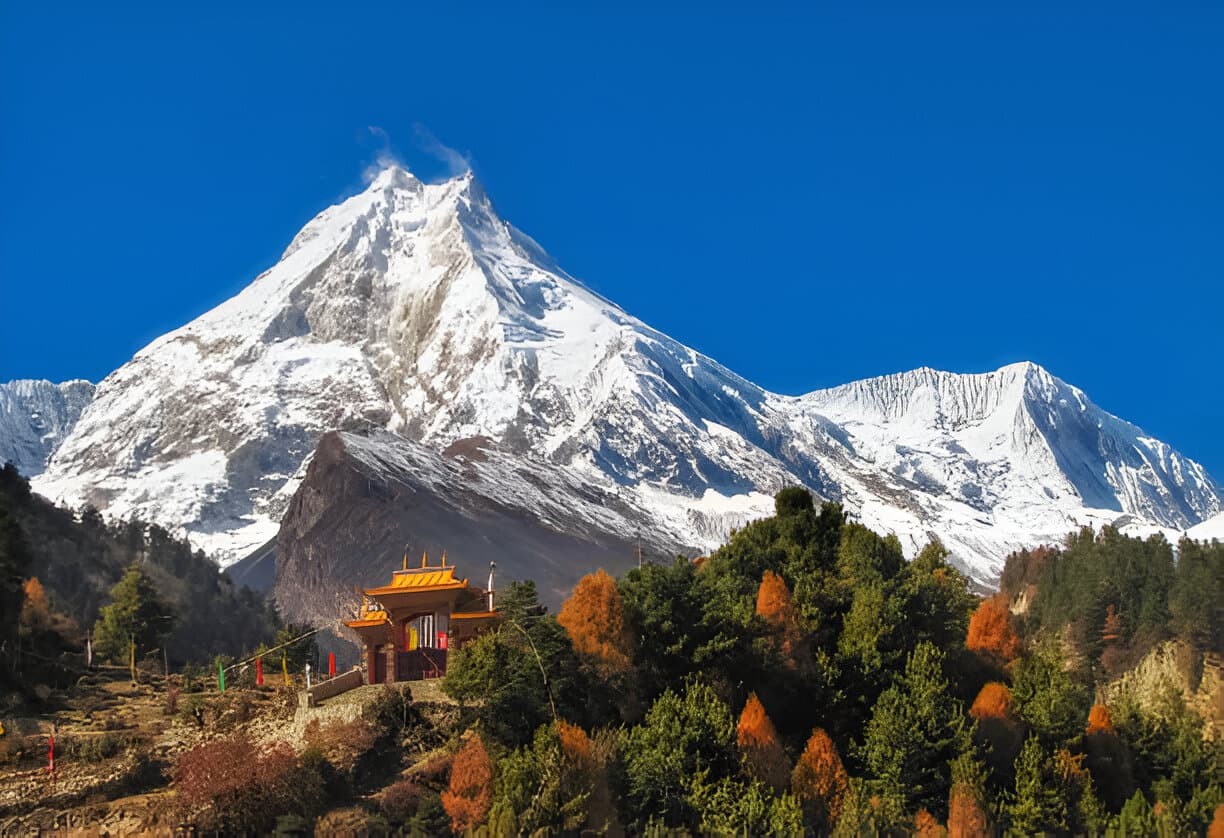
Manaslu Circuit Trek – A Complete Guide
Manaslu Circuit Trek is among Nepal’s most traditional and fulfilling treks that offers a real Himalayan trekking experience. Often eclipsed by its well-known cousin, the Annapurna Circuit, the Manaslu Circuit is a hidden treasure tucked between the Ganesh Himal and the great Annapurna line. Trekkers on this amazing path go historically and culturally via isolated wilderness, Tibetan-influenced communities, and secluded valleys. originally a salt-trading route with Tibet, the walk offers an amazing window into a bygone age surrounded by the Himalayan majesty. Following old roads originally used as such.
The Manaslu Circuit distinguishes itself with its amazing landscape and cultural diversity. Rising majestically along the way, snow-capped mountains dominate the skyline with the eighth highest mountain in the world, Manaslu, standing at 8, 163 meters. This walk is a feast for the sight as glacial tops and deep river gorges produce an amazing contrast. The path runs through Tibetan-style communities where life stays anchored in custom. Villagers coexist peacefully with their environment, giving hikers chances to encounter real Himalayan culture and friendly hospitality.
The Manaslu Circuit is a limited area due to its isolated character; access calls for particular licenses and permits. This control has ensured the region does not suffer the significant footfall observed in other well-known trekking areas, therefore helping to retain its cultural uniqueness and pure surroundings. The routes are so very quiet, which lets one enjoy a calm journey among pristine natural beauties.
The Manaslu Circuit Trek provides the ideal mix of natural beauty, cultural discovery, and adventure regardless of your level of experience as a trailwalker or search for a different challenge. This trip will leave you with lifetime memories of the Himalayan wilderness and the lovely people living in this area.
Table of Contents
-
- What Makes the Manaslu Circuit Trekking a Special Trek?
- The Best Time To Do The Manaslu Circuit Trek
- How Difficult Is The Manaslu Circuit Trek?
- What Permits Do You Need for the Manaslu Circuit Trek?
- Accommodation and Food during the Manaslu Circuit Trek
- How to Identify and Prevent AMS on the Manaslu Circuit Trek
- Manaslu Circuit Trek Itinerary
- Manaslu Circuit Trek Top FAQs
- Top 8 Reasons to do Manaslu Circuit Trek
What Makes the Manaslu Circuit Trekking a Special Trek?
Still a favorite among adventure seekers for its unusual mix of natural beauty, cultural diversity, and off-the-beaten-path appeal, the Manaslu Circuit Trek is situated in the isolated Manaslu region of Nepal. Perfect for those looking for seclusion and a closer touch with nature, the Manaslu Circuit provides a considerably more quiet and less congested travel than the main trekking paths like the Everest Base Camp or Annapurna Circuit.
The Trek’s cultural variety is among its key attractions. You will come across many ethnic groups as you travel through beautiful towns, like the Nubri and Tsum people, whose way of life is still anchored in old customs shaped by Tibetan Buddhism. Trekkers have opportunity to fully experience the spiritual and cultural appeal of the area thanks to villages featuring vibrant prayer flags, historic monasteries, and mani walls—stone walls bearing prayers.
Along the Manaslu Circuit, the surroundings are just amazing. The path runs by terraced farms, rhododendron blossoms, rich alpine woods, and deep gorges sculpted by strong rivers. Trekkers are in wonder when they witness the Himalayan mountains panoristically, especially Mount Manaslu (8, 163m)—the eighth highest mountain in the world. The area is rich in biodiversity, hence along the trip you may also see an amazing range of flora and fauna including blue sheep, Himalayan tahrs, and many bird species.
One of the highest and most dramatic mountain passes in Nepal, the Larkya La Pass (5,106m) stands as a main highlight of the journey. Trekkers who cross the snow-covered pass will have breathtaking views of the glaciated mountains and a great sense of accomplishment for having completed one of the most difficult portions of the trail.
The teahouse lodging scattered along the Manaslu Circuit Trek adds still another element that distinguishes it. Trekkers may enjoy traditional Nepali cuisine including Tibetan bread or dal bhat (rice and lentil soup) while experiencing local friendliness in these modest yet comfortable teahouses. The encounter is much more unforgettable in the warmth and friendliness of the residents.
The fact that the Manaslu area is a restricted area needing specific permits gives the trip more exclusiveness. These limits help to control the number of hikers, therefore preserving the natural beauty and cultural legacy of the area. Unlike other popular paths, this lack of commercialization encourages an adventure and authenticity that is becoming difficult to come by.
The Manaslu Circuit provides an unmatched experience for those seeking a more adventurous, peaceful, and culturally enhancing walk. It is a very unique trip in the heart of the Himalayas since it mixes the excitement of trekking over high-altitude settings with the possibility to really connect with nature and local people.
The Best Time To Do The Manaslu Circuit Trek
The Manaslu walk is best timed for the pre-monsoon (spring) and post-monsoon (fall) seasons. The particular months thought perfect for the trip are:
One of the most often used seasons for the Manaslu Circuit Trek is spring, from March to May. Spring brings warm temperatures and typically stable conditions in the weather. The bloom of the rhododendron gives the scene vivid colors. The great visibility provides unhindered views of the Himalayan mountains.
Two additional ideal times for the Manaslu Circuit Trek are fall, which runs from September to November. The sky are usually clear and the weather is steady and dry. The temperatures are pleasant, and the outstanding vistas of the surrounding mountains come from the great clarity. Peak trekking season in Nepal is thought to be autumn.
These seasons provide good weather, hence trekking is more fun and safe. Trekking is less suited in the Manaslu area, though, as the monsoon season (June to August) brings strong rains and the region is prone to significant snowfall during the winter months (December to February).
Check the current weather before starting the journey and be advised of any changes in rules or hiking licenses. Furthermore influencing the decision on the ideal time to go the Manaslu Circuit Trek might be personal preferences including tolerance for cooler weather or a wish for less tourists.
How Difficult Is The Manaslu Circuit Trek?
The Manaslu Circuit Trek presents a tough but worthwhile Himalayan journey. Technically, the walk is really easy since it mostly entails walking on well-used paths. In some areas, particularly as you climb to higher altitudes, the ground can become uneven and tough, though. Teahouses along the path provide a degree of convenience by removing the need to carry bulky camping gear and enabling trekkers to relax in relative comfort following lengthy distances of walking.
The Manaslu Circuit Trek’s primary difficulty is its length and great altitude. At the Larkya La Pass, a site that is snow-covered for much of the year, the climb reaches a maximum elevation of 5,106 meters. At such heights, the air gets thin, and altitude sickness might start to worry trekkers who climb too quickly without enough acclimatization. With steep climbs, frigid temperatures, and treacherous, snow-covered paths calling for endurance, concentration, and tenacity, Larkya La Pass can be especially demanding.
The distance of the Manaslu Circuit further increases the physical difficulty. Over 10–14 days, the approximately 122 km journey entails notable height gain and many difficult days of walking—some of which span 15 kilometers. Even experienced hikers can get cumulative tiredness from long hiking hours, uneven ground, and the physical toll of altitude.
Notwithstanding these obstacles, the joys and beauty of the trail much exceed any difficulty. Your capacity to meet the physical demands will be much enhanced by appropriate preparation including endurance activities, lower body strength strengthening, and cardiovascular conditioning. Key techniques for success are to keep a steady, reasonable pace and approach altitude gradually over acclimatization days.
In the end, finishing the Manaslu Circuit makes one quite proud. The trip is so rewarding because of this very difficulty—the high-altitude passes, lengthy hiking days, and amazing terrain. For those who tackle the walk with the correct attitude, enough gear, and enough preparation, the Manaslu Circuit is not only reachable but also a life-changing experience through one of Nepal’s most beautiful and unspoiled areas.
What Permits Do You Need for the Manaslu Circuit Trek?
To trek in the Manaslu region, you will require three key permits issued by the Government of Nepal. These permits ensure compliance with trekking regulations and help preserve the region’s natural and cultural heritage.
1. Manaslu Restricted Area Permit (RAP)
The Manaslu region is classified as a restricted area to preserve its unique culture and environment. The RAP is mandatory for all trekkers.
- Permit Costs:
- September to November: USD 100 per person for the first 7 days, with an additional USD 15 per day for each extra day.
- December to August: USD 75 per person for the first 7 days, with an additional USD 10 per day for each extra day.
The RAP is strictly regulated, and trekkers must travel with a licensed guide as part of an organized trekking group.
2. Manaslu Conservation Area Permit (MCAP)
The Manaslu Conservation Area Permit is essential for entering the protected conservation area surrounding the Manaslu Circuit. This permit helps fund conservation efforts and sustainable tourism initiatives.
- Where to Obtain: The MCAP can be acquired in Kathmandu, Pokhara, or at the entry points to the Manaslu region.
3. Annapurna Conservation Area Permit (ACAP)
The Annapurna Conservation Area Permit is required because the Manaslu Circuit often connects with parts of the Annapurna region towards the end of the trek, particularly around Dharapani.
- Where to Obtain: Similar to MCAP, the ACAP can be arranged in Kathmandu, Pokhara, or at designated entry points.
Permit Arrangements
For your convenience, our local team in Nepal will handle all permit arrangements on your behalf. We ensure the process is smooth, so you can focus on enjoying your trek. Please remember to carry passport-sized photos and a copy of your passport for permit applications.
With these permits, you can explore the breathtaking beauty, cultural richness, and remote charm of the Manaslu Circuit while adhering to all legal requirements.
Accommodation and Food during the Manaslu Circuit Trek
Like other well-known trekking areas in Nepal, notably Annapurna and Everest, the Manaslu Circuit Trek mostly depends on tea house lodging. Trekkers depend on these tea shops as vital rest areas since they provide a friendly environment and let them to fully experience the native way of life.
Along the Manaslu Circuit, tea houses offer simple yet useful conveniences ideal for the demanding surroundings of high-altitude trekking.
Usually basic, rooms consist of twin mattresses with a pillow, blanket, and communal toilets. Higher altitudes could cause lodging to get more basic with little warmth. One really needs a warm sleeping bag.
Commonly including a wood-burning stove as the principal heating source, communal dining rooms provide a warm setting for hikers to meet, dine, and mingle. Usually, meals are presented on a regular timetable.
To keep trekkers going, tea shops provide a range of basic but filling meals.
Commonly served are local favorites such Tibetan bread, soups, noodles, dumplings (momos), Dal Bhat (rice, lentil soup, and veggies), Particularly Dal Bhat is an energetic staple that usually comes with infinite refills.
Popular drinks to stay warm in frigid climes are coffee, hot tea, ginger lemon honey.
Trekkers should expect simpler menus as they climb to higher altitudes, even if some tea shops at lower altitudes could offer extra choices like pasta or pancakes.
How to Identify and Prevent AMS on the Manaslu Circuit Trek
Understanding altitude sickness, also known as Acute Mountain Sickness (AMS), is crucial when trekking the Manaslu Circuit. AMS can affect anyone, regardless of age, fitness level, or prior experience at high altitudes. Today, there are effective tools to monitor your health, such as the Lake Louise Scorecard, a widely used method by guides to identify altitude-related symptoms and their severity. Modern guides also carry pulse oximeters to measure blood oxygen saturation and heart rate, both key indicators of altitude adaptation.
Here’s a comprehensive guide on identifying AMS symptoms and ways to prevent them to ensure a safe and enjoyable trek.
What is Acute Mountain Sickness (AMS)?
AMS occurs when the body struggles to adapt to reduced oxygen levels at higher altitudes. It is a potentially serious condition that demands immediate attention. While most trekkers will experience mild symptoms, it’s essential to act quickly to prevent escalation into life-threatening conditions.
Symptoms of AMS
Be alert to the following symptoms:
- Headache
- Nausea and vomiting
- Loss of appetite
- Insomnia
- Shortness of breath
- Fatigue
- Dizziness
If left untreated, AMS can escalate into severe forms like:
- High Altitude Pulmonary Edema (HAPE):
- Cause: Fluid buildup in the lungs.
- Symptoms: Shortness of breath, persistent cough, chest tightness, rapid heartbeat.
- Action: Immediate descent is required, as this can be life-threatening.
- High Altitude Cerebral Edema (HACE):
- Cause: Fluid accumulation in the brain.
- Symptoms: Severe headaches, confusion, lack of coordination, altered mental state.
- Action: Immediate descent and medical attention are critical.
7 Ways to Prevent AMS
- Gradual Ascent
Ascend slowly to allow your body to acclimatize. Avoid gaining more than 300–500 meters in sleeping altitude per day. All treks, including the Manaslu Circuit, are planned with acclimatization days for safety. - Stay Hydrated
Dehydration increases the risk of AMS. Drink plenty of water and avoid alcohol and excessive caffeine, as these contribute to dehydration. - Balanced Diet
Eat a nutritious diet rich in carbohydrates to help your body process oxygen more efficiently. Avoid heavy, fatty foods at high altitudes. - Medication
Preventive medications like acetazolamide (Diamox) may help some individuals adapt better. Consult your doctor beforehand to discuss its suitability and potential side effects. - Rest and Sleep
Proper rest is essential for altitude adaptation. Avoid pushing yourself too hard; fatigue can worsen AMS symptoms. - Avoid Overexertion
Pace yourself while trekking. Listen to your body and take breaks as needed. If you notice early symptoms of AMS, stop, rest, or descend. - Immediate Descent if Symptoms Persist
Never ignore AMS symptoms. If you experience persistent headaches, nausea, dizziness, or difficulty breathing, descend to a lower altitude immediately. Ignoring these signs could lead to life-threatening conditions like HAPE or HACE.
Manaslu Circuit Trek Itinerary
Day 1: Drive from Kathmandu to Soti Khola (710m)
Highlights: Scenic drive along rivers, terraced fields, and traditional villages.
Altitude Gain: +710m.
Driving Hours: 7–8 hours by jeep or bus.
Day 2: Trek from Soti Khola to Machha Khola (900m)
Highlights: Walk through sal forests, pass by waterfalls, and cross suspension bridges.
Altitude Gain: +190m.
Walking Hours: 6–7 hours.
Day 3: Trek from Machha Khola to Jagat (1,340m)
Highlights: Follow the Budi Gandaki River, pass through Khorlabesi and Tatopani (hot springs).
Altitude Gain: +440m.
Walking Hours: 6–7 hours.
Day 4: Trek from Jagat to Deng (1,860m)
Highlights: Enter the restricted area, pass Philim, and admire the gorge and waterfalls.
Altitude Gain: +520m.
Walking Hours: 6–7 hours.
Day 5: Trek from Deng to Namrung (2,630m)
Highlights: Hike through forests of pine and rhododendron, encounter Tibetan influences.
Altitude Gain: +770m.
Walking Hours: 6–7 hours.
Day 6: Trek from Namrung to Samagaon (3,520m)
Highlights: Panoramic views of Himalchuli and Ganesh Himal, pass Tibetan-style villages.
Altitude Gain: +890m.
Walking Hours: 7–8 hours.
Day 7: Acclimatization Day in Samagaon (3,520m)
Highlights: Rest or short hikes to Manaslu Base Camp (4,400m) or Pungyen Gompa.
Altitude Gain: None (unless optional hikes).
Walking Hours: 3–5 hours for optional hikes.
Day 8: Trek from Samagaon to Samdo (3,875m)
Highlights: Gradual ascent through alpine landscapes, views of the Tibetan plateau.
Altitude Gain: +355m.
Walking Hours: 4–5 hours.
Day 9: Acclimatization Day in Samdo (3,875m)
Highlights: Rest or hike to Tibetan border viewpoints or Lajyung La Pass.
Altitude Gain: None (unless optional hikes).
Walking Hours: 3–4 hours for optional hikes.
Day 10: Trek from Samdo to Dharamsala/Larkya Phedi (4,460m)
Highlights: Stunning views of Larkya Glacier and surrounding peaks.
Altitude Gain: +585m.
Walking Hours: 4–5 hours.
Day 11: Cross Larkya La Pass (5,106m) and trek to Bimthang (3,590m)
Highlights: Epic high pass crossing with spectacular views of Manaslu, Himlung, and Annapurna.
Altitude Gain: +646m (ascent), -1,516m (descent).
Walking Hours: 8–10 hours.
Day 12: Trek from Bimthang to Dharapani (1,860m)
Highlights: Descend through forests, rivers, and picturesque villages.
Altitude Gain: -1,730m.
Walking Hours: 7–8 hours.
Day 13: Drive from Dharapani to Kathmandu (1,400m)
Highlights: Scenic drive back to the capital through winding mountain roads.
Altitude Gain: -460m.
Driving Hours: 8–9 hours.
Manaslu Circuit Trek top FAQs
Why did Manaslu name Killer Mountain Killer Mountain?
Given its perilous climbing conditions, Manaslu is known as the “Killer Mountain”. Because of its steep slopes, variable weather, avalanches, and crevasses—which make it quite difficult even for experienced climbers—the mountain boasts a high fatality rate.
Following a sad event in 1972 when an avalanche claimed fifteen lives on a Korean trip, the term gained general recognition. This incident made clear the inherent dangers of ascending Manaslu, hence giving it the sinister moniker “Killer Mountain.
How difficult is Manaslu Circuit Trek?
There are plenty of ups and downs on this physically taxing path. The trip is exhausting because of multiple switchbacks and river crossings. The path is dangerous at various places since it passes landslide regions. Technically, nevertheless, there is no climbing. Walking on worn-out foot paths is simple. Crossing Larkya La marks the toughest part of the walk. The mountain pass is snowy and features several steep hills, which makes crossing challenging.
Which trekking is more challenging between Manaslu Circuit Trek and Everest Base Camp Trek?
Examining the altitude profile of both hikes reveals that Everest Base Camp is harder than Manaslu Circuit. The Everest Base Camp trail leads to heights exceeding 5000 meters, when the atmospheric oxygen content is just half that of sea level. Furthermore included in the EBC Trek schedule are three nights at Lobuche and Gorak Shep, at a 5000-meter elevation. Certainly not easy is sleeping and walking at this elevation.
At 5106 meters, the Larkya La pass on the Manaslu Circuit path stands as the highest point. Although the climb to the pass is difficult enough, the time spent there is just few minutes. Following your ascent over the pass, you will rapidly descend to Bhimthang, located at 3590 meters.
Although the Manaslu Circuit has little elevation rise, the physically demanding journey is made by the twisting, small paths across deserted areas. The settlements are further apart, and the path leads to populated areas after a steep climb. Along the path of the Everest Base Camp, there are numerous Sherpa communities where one may stop to eat and relax at regular intervals.
The Everest trail also contains well-facilitated lodges and teahouses, therefore improving the degree of comfort on the trip. On the Everest path, there are also opulent mountain hotels providing premium services to the hikers.
The teahouse amenities on the Manaslu Circuit are simpler and more primitive than those of the Everest Base Camp path. The lodges are less contemporary and less conveniently accessible than on the EBC path. But the growing traffic in the Manaslu Region over the past few years has caused the residents to improve the teahouse amenities.
How should one prepare for Manaslu Trek?
You should be rather fit before beginning your journey. Training for your trip should begin at least six months ahead. You can jog, climb stairs, and go uphill carrying a big bag. Exercises meant to strengthen your back, core, and leg muscles can help you Regular cardio exercises—swimming, aerobics, cycling, jogging, etc.—will increase your stamina and strengthen your lungs and heart. Additionally crucial is a balanced food for your trek’s preparation.
Training for a high-altitude walk from a lower height is challenging. Still, you need be careful trekking to prevent altitude sickness. Keeping oneself hydrated by drinking lots of fluids, keeping yourself warm, keeping a slow but steady pace when walking, breathing deeply and never overdoing yourself are some of the ways you could lessen the affects of high altitude on your body.
Is Manaslu Circuit Trek tougher than Annapurna Circuit Trek?
Comparatively to the Annapurna Circuit, the Manaslu Circuit is rather more difficult. The first several days of the Manaslu Circuit Trek have plenty of ups and downs, which physically drains one. The Manaslu loop is more difficult than the Annapurna Circuit due in part to multiple switchbacks and river crossings. On the Manaslu side, the lodges are likewise rudimentary, and the communities are further separated, which results in considerable daily walking distances.
There are several settlements along Annapurna Circuit with nice lodging. Navigating the Annapurna Circuit’s simple jeep routes is also easier than negotiating the Manaslu Circuit’s twisting and mountainous paths.
How difficult is to cross the Larke La Pass?
Rising at 5106 meters, the Larkya La Pass is the highest point on the Manaslu Circuit Trek. One will be walking on snow and ice and climbing and descending on steep portions, thus crossing the pass is rather difficult. From Dharamshala to cross the Larya La pass, the climb takes eight to nine hours. The snow and ice covering the pass make crossing challenging. Your journey will begin before daybreak. Making an early start is recommended since the weather gets bad as the day goes on. Up to the pass across boulder fields and frozen trails, this is a taxing climb. The trip is more difficult because of the low oxygen level and frigid temperatures. Likewise difficult and demanding is the steep drop to Bimthang. The amazing and magnificent vistas of the mountains are a major prize for the difficult crossing of Larkya La.
How long is the Manaslu Circuit Trekking?
The schedule you select and the pace you keep during your journey will determine the length of the trip. The Manaslu Circuit Trek takes usually 11 to 14 days to finish. Still, depending on the side trips and detours, the walk can last eighteen days or more. Most hikers would rather incorporate a side excursion to Tsum Valley, which takes four to five days extra. The path runs around 180 kilometers from Machakhola to Dharapani.
How much does it cost for Manaslu Circuit Trek?
Every outfitter costs different for the trip. The agency you choose, the services you are ready to pay for, and your trail expenditure—on hot showers, wifi, snacks, beverages, etc.—will determine the cost of the trip. The agency will charge less if you pay just for the porter’s and guide services. You will have to pay a lot though if the overall cost of your trip includes meals, lodging, and transportation expenses as well. To make your trip hassle-free, it is advisable to let the outfitter handle all the administrative aspects. Additionally included in the overall cost are permits.
Is it worth doing the Manaslu Circuit Trek?
Indeed, the Manaslu Circuit route is quite worth seeing. The walk leads you off the usual route to some of the Himalayan seldom visited sites. The forests beside the path are unspoiled and unaltered. This is among the top multi-day treks in the Nepal Himalayas based on the natural beauty and close-up perspective of an eight-thousand-meter peak.
Top 8 Reasons to do Manaslu Circuit Trek
1. Sceneries and Himalayas
The Manaslu trek is a thrilling Himalayan trek in Nepal, offering breathtaking views of snow-covered Himalayan peaks and stunning panoramas. The trek route includes Himalchuli, Manaslu, Shringi, Ganesh Himal, Ngadi Chuli, Himlung Himal, Cheo Himal, Kang Guru, Annapurna II, Larkya Peak, and more. The diverse landscapes, including exotic wilderness and extensive vegetation, make the trek an unforgettable experience.
2. Larkya La Pass- Cross 5125 m
The Manaslu trek, a thrilling adventure in Nepal, includes the challenging Larkya La pass, the highest point on the Around Manaslu trek route. This pass offers breathtaking views of the majestic Himalayas, making it an ideal destination for those who enjoy challenging high passes in the Nepalese Himalayas.
3. Less Crowded and Peaceful Trail
Manaslu Circuit trekking offers a less crowded and peaceful trail compared to other popular Nepalese trails. Despite its remote location, the trek attracts a smaller number of trekkers, making it a perfect destination for peace seekers. The trek offers a thrilling journey to the top of Larkya La, providing unforgettable memories.
4. Remote and Unspoiled Trekking Trails
Trekking through the remote trails of Manaslu offers a unique experience with untouched natural beauty and varying topography. The trek offers a chance to explore the perfect nature, witnessing wildlife at their natural habitat, and witness the basic life of the small settlements. This less touristy and less commercial trek route is perfect for trekking enthusiasts seeking tranquil trails with local inhabitants, culture, and diverse ecosystems.
5. Safe and Moderately Strenuous Routes
Manaslu Circuit Trek is a beautiful and safe journey, but requires moderate fitness and a strong heart. Due to high altitudes, health issues like altitude sickness, injuries, and knee pain are possible. Consult a medical advisor before embarking on the trek. The trek is moderately strenuous, but not difficult for average trekkers. Follow guide instructions, avoid solo hiking, and exercise before starting. Proper acclimatization and walking at one’s own pace can reduce altitude sickness risks. Enjoy a safe and exciting journey to Manaslu Circuit.
6. Manaslu Conservation Area
Trekking in Manaslu, a protected area, offers a unique experience with diverse topography and vegetation. The Manaslu Conservation area spans from 1400 meters to 8156 meters, encompassing forests, rivers, lakes, and wildlife species. The trek offers opportunities to encounter wildlife and birds, with peaceful trails and melodious bird chirps making it an ideal destination for nature lovers.
7. Beautiful Lakes
The Manaslu Circuit trek offers a unique experience with high altitude freshwater lakes, including Birendra Tal and Phunkar Tal. Trekkers can also visit Birendra Lake, located in Manaslu Glacier, which is home to rare alpine migratory ducks, providing an exciting adventure.
8. Local culture and people
Manaslu, a region with a rich history and culture, shares similarities with Tibet. Trekking through the Manaslu circuit offers unique cultural experiences, including visits to monasteries and the Tsum valley. The region’s traditional lifestyle and Buddhism are evident, with stupas, monasteries, gompas, prayer wheels, and chortens. The Mu Gompa, the largest monastery in the region, is a highlight. The Manaslu circuit also features sacred caves, believed to be the site of Guru Rinpoche’s meditation.

